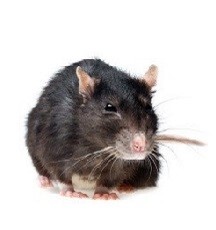Rats
There are two main type of rat that are common to our shores.
Firstly the brown rat, heavy-bodied, six to eight inches long, with small eyes and ears and blunt nose. Tail is shorter than head and body. Its fur is shaggy.
Droppings are capsule-shaped. Nests in underground burrows. Tends to remain in hiding during the day.
Omnivorous, but prefers meats. Cannot survive long without water. Reaches sexual maturity in two months and can breed any month of the year. Litter may number from eight to twelve. Females can have four to seven litters per year. Adults live as long as one year.
Secondly the black rat, pointed nose, larger ears than the brown, tail longer than head and body. Lives mainly higher than ground level like in roof space, prefers moist fruits. Same breeding cycle as brown rat.
Mice
Small and slender, three to four inches long, with large ears, small eyes and pointed nose. Light brown or light gray. Droppings are rod-shaped. Nests are within structures and burrows.
They establish a “territory” near food sources that are generally 10 to 30 feet from the nest. Inquisitive, but very wary, excellent climbers.
Mice are omnivorous, but prefers cereal grains. They are prolific breeders by two months of age. Can have litters as often as every 40 or 50 days, with four to seven young per litter. Live up to one year.
Cockroaches
Some species invade human dwellings and are considered pests. These cockroaches can be carriers of various diseases because they are commonly found near waste deposits or in the kitchen, where food is present.
Cockroaches can measure over one inch in length. Cockroaches have six legs, two antennae and wings. However, a number of winged cockroaches are not particularly adept at flying. Large cockroach infestations emit unpleasant odours.
Cockroaches can enter your home in many different ways, from the outside through cracks and crevices, vents, sewer and drain pipes. We even bring them in on products like grocery bags, boxes, purses and on our person! Your home is an ideal breeding ground most species of cockroaches. With plenty of food, warmth, water and nesting sites, they can remain active all year round. Cockroaches reproduce quickly.
For every one you see there can be many, many more hiding and multiplying behind your wall. Because cockroaches are nocturnal, if you’ve seen one, you probably haven’t seen them all. The few cockroaches you see by day could mean they were likely forced out by overcrowding; a possible sign of severe infestation.
Bed Bugs
Bed bugs are flat, reddish-brown, oval insects about 3/16-inch long or the size of an apple seed. Swollen and reddish after a blood meal.
They live in cracks and crevices including mattress seams, sheets, furniture, behind headboards, electrical outlet plates and picture frames. Often found in hotels, where they can travel from room to room and in visitors’ luggage.
They feed on blood.Females can deposit one to five eggs a day, and may lay 200 to 500 eggs in a lifetime. Under normal room temperatures and with an adequate food supply, they can live over 300 days.
Blood spotting on mattresses and nearby furnishings are signs of a infestation. Their bites can leave itchy welts on the skin and can cause allergic reactions, such as severe itching. There are different types of bed bugs, but the common bed bug with a scientific name of Cimex lectularius, is adaptable to human environments.
Since they can survive in birds’ nests, they can be seen in houses and buildings that have several bird nests, particularly on rooftops. Bed bugs are also known to feed on bats or household pets, but their typical source of nutrition is human blood.
Other pest information can be e-mailed to you on request.
Ants. Beetles. Biting insects. Flies. Moths. Squirrels. Wasps.




